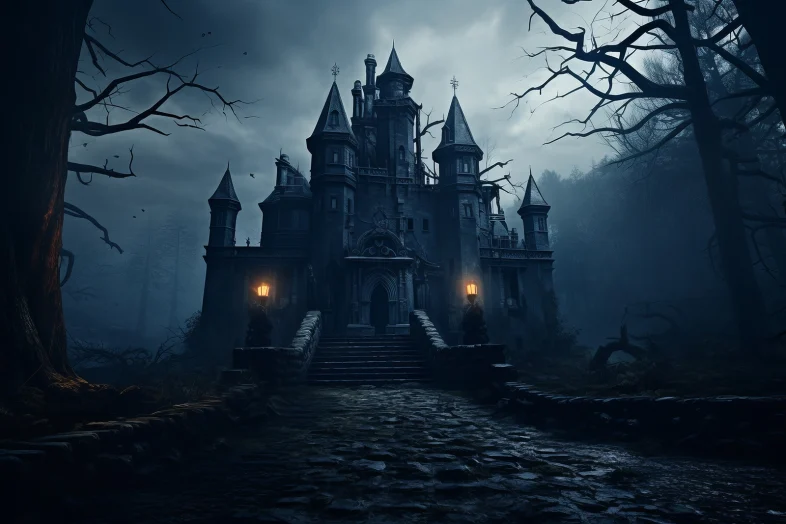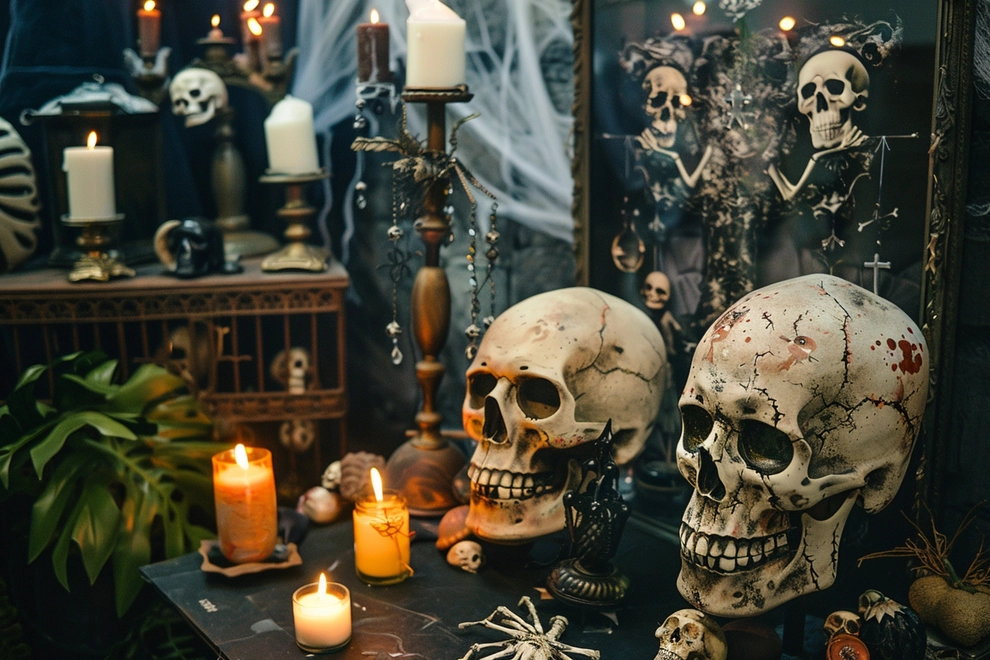
Vampires have long been symbols of darkness, sensuality, and rebellion, making them perfect icons in the world of Gothic culture. Their allure, born out of a need for blood and a promise of immortality, has transcended centuries and continues to inspire stories, fashion, and even lifestyles today. Gothic culture, with its fascination for the macabre and the mysterious, embraces vampires not just as monsters but as reflections of the darker sides of human nature—longing, power, seduction, and the taboo.
In this piece, we explore the origins of the vampire myth, how vampires have evolved in literature and film, and how these creatures have become a staple of Gothic fashion and subculture. Vampires are more than just figures of horror—they represent eternal outsiders, dark romantics, and symbols of the forbidden.
The Origins of the Vampire Myth
Before vampires became the glamorous creatures we know today, they were sinister and feared entities in various folklore traditions around the world. Though much of vampire lore is associated with Eastern Europe, nearly every culture has its version of the undead. In ancient Mesopotamia, the “Lilu” demons were believed to steal life from sleeping people, while in Greek mythology, the “Empusa” was a blood-drinking demon.
However, the Slavic regions of Eastern Europe birthed the vampire myths most closely tied to modern Gothic culture. In countries like Serbia and Romania, vampires, or “vampirs” and “strigoi”, were said to be restless dead who returned from their graves to feed on the living. These myths spread terror throughout rural communities, where dark forests and shadowy cemeteries served as fertile ground for stories of the undead. This early vampire lore painted them as decaying corpses, grotesque and far from the charming figures that would later dominate Gothic media.
In medieval Europe, the fear of vampires was connected to religious superstition and the dread of the unknown. People believed that improper burials or sinful lives could result in someone becoming a vampire after death. The terror was so widespread that suspected vampires were exhumed and staked through the heart to prevent them from rising from their graves. It was a time when death felt ever-present, and the idea of an undead creature feeding on the living struck at the core of existential fears.
Vampires in Gothic Literature
The vampire’s shift from folklore to Gothic icon began with early literary representations, but it was truly cemented in the 19th century, when the creature transformed into the seductive yet dangerous figure so beloved in Gothic fiction. John Polidori’s *The Vampyre* (1819) was one of the first stories to depict a vampire in a more humanized, aristocratic form. Lord Ruthven, the protagonist, was sophisticated, elegant, and deadly—traits that would echo in later vampire stories.
But it was Bram Stoker’s *Dracula* (1897) that brought the vampire fully into Gothic literature’s dark embrace. Count Dracula, with his eerie Transylvanian castle, nocturnal habits, and hunger for human blood, became the quintessential vampire. His connection to themes of forbidden desire, the uncanny, and the foreign made him a powerful figure within the Gothic tradition. Dracula embodied the fears of Victorian society—particularly surrounding sexuality, immigration, and the otherworldly.
In Gothic literature, vampires are often representations of the ultimate outsider, reflecting the isolation and alienation that so many within the Gothic subculture identify with. They are both alluring and dangerous, existing outside the norms of society, living forever on the fringes of humanity.
The Gothic Appeal of Vampires in Film and TV
As Gothic fiction found its way into cinema, so did the vampire, becoming one of the most iconic figures in Gothic horror. F.W. Murnau’s *Nosferatu* (1922) presented a hideous, almost rat-like vampire in Count Orlok, who preyed on innocents under the shroud of night. This film is a masterpiece of German Expressionism, casting long, ominous shadows and creating an atmosphere of dread that perfectly aligns with Gothic aesthetics.
In the mid-20th century, Hammer Horror films brought a new type of vampire to life, with Christopher Lee’s portrayal of Dracula transforming the vampire into a brooding, erotic anti-hero. His tall, imposing figure, piercing gaze, and red-lined cape made him the embodiment of Gothic seduction—combining danger with dark romance. These films leaned heavily into Gothic aesthetics, from the crumbling castles to the misty landscapes, making vampires not just creatures of fear but of intense, forbidden allure.
More recently, television shows like *Buffy the Vampire Slayer* (1997–2003) and *The Vampire Diaries* (2009–2017) have introduced vampires that are complex and conflicted, often torn between their dark nature and their human emotions. These portrayals have become particularly resonant within the Gothic community, as they speak to themes of internal conflict, the battle between light and dark, and the eternal struggle to balance humanity with darker impulses.
Vampires in Gothic Subculture and Fashion
Vampires are not just fictional characters; they have inspired an entire aesthetic and lifestyle within the Gothic subculture. The “vampiric look” in Gothic fashion has become iconic, drawing on elements of Victorian mourning attire, fetish wear, and a distinctly dark romantic style. Pale skin, black clothing, red accents (to symbolize blood), and elaborate jewelry are staples of vampire-inspired Gothic fashion. Velvet, lace, corsets, and capes evoke the aristocratic elegance often associated with literary vampires, while dark makeup, particularly blood-red lips, complete the look.
The Goth community’s fascination with vampires goes beyond appearance. Vampires symbolize eternal youth, rebellion against societal norms, and the embracing of one’s inner darkness—all core aspects of Gothic identity. In many ways, vampires are the perfect Gothic archetypes: outsiders who live by their own rules, shrouded in mystery, and defying the conventions of life and death.
The vampire lifestyle subculture also deserves mention. In cities around the world, modern-day “vampires” adopt vampiric personas, engaging in role-playing, blood rituals, and wearing elaborate costumes to create a sense of connection with these mythic figures. While some engage in vampirism for fun or fashion, others embrace it as a way of life, participating in communities where they express their identities as vampires through art, writing, and performance.
The Eternal Allure of Vampires in Gothic Music and Media
Vampires have also left their mark on Gothic music, particularly within the goth and darkwave genres. Bands like Bauhaus helped define the genre with tracks like “Bela Lugosi’s Dead,” a dark, atmospheric tribute to the actor who famously portrayed Dracula. This song, with its haunting melodies and eerie lyrics, became an anthem for the Goth scene, merging the themes of death and undead into a musical form that resonates deeply within the subculture.
Other bands, such as The Sisters of Mercy and Type O Negative, have also drawn inspiration from vampiric imagery, exploring themes of immortality, love, and despair. The vampiric aesthetic permeates not just the lyrics but the performances themselves, with shadowy lighting, black attire, and moody, theatrical stage presence. For many Goths, the vampire represents not just a character, but a way of embodying themes of sorrow, seduction, and eternal darkness in a musical context.
Beyond music, vampires have become a fixture in Gothic-themed video games, comics, and graphic novels. Titles like *Vampire: The Masquerade* allow players to immerse themselves in a world where vampiric politics, morality, and bloodlust take center stage. These games resonate with the Gothic crowd, offering a way to explore the darker sides of human nature in a fantasy setting.
Vampires as Symbols of Rebellion and Desire
In Gothic culture, vampires are often seen as metaphors for rebellion against societal norms. They live outside the constraints of human morality, gender expectations, and life itself. This sense of being “other” is something that resonates with many in the Gothic scene, who also see themselves as existing outside mainstream society.
Vampires are also symbols of desire—both physical and emotional. Their need for blood mirrors human cravings for connection, passion, and intimacy. But unlike mortals, vampires take these desires to the extreme, crossing boundaries that are forbidden to the living. In this way, they embody a form of dark, dangerous romance that appeals to the Gothic sensibility, where love and death are often intertwined themes.
The vampire, in all its forms, remains a powerful and enduring figure in Gothic culture. Whether as monsters, romantic anti-heroes, or symbols of rebellion, vampires continue to captivate the Gothic imagination. They offer a reflection of our darkest desires and fears, and within the world of Goths, witches, and other dark subcultures, they are celebrated as eternal icons of the night. As long as there are shadows to hide in and forbidden desires to explore, vampires will remain an indelible part of the Gothic world.
From their bloody origins in folklore to their glamorous depictions in fashion and music, vampires are more than just creatures of myth—they are symbols of the Gothic soul itself. Their immortality mirrors the timeless appeal of the Gothic subculture, ensuring that they will forever stalk the pages of Gothic literature, the stages of darkwave music, and the dreams of those who walk in the night.




Add Comment